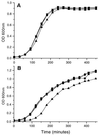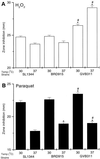The alternative sigma factor, sigmaE, is critically important for the virulence of Salmonella typhimurium
- PMID: 10084987
- PMCID: PMC96497
- DOI: 10.1128/IAI.67.4.1560-1568.1999
The alternative sigma factor, sigmaE, is critically important for the virulence of Salmonella typhimurium
Abstract
In Escherichia coli, extracytoplasmic stress is partially controlled by the alternative sigma factor, RpoE (sigmaE). In response to environmental stress or alteration in the protein content of the cell envelope, sigmaE upregulates the expression of a number of genes, including htrA. It has been shown that htrA is required for intramacrophage survival and virulence in Salmonella typhimurium. To investigate whether sigmaE-regulated genes other than htrA are involved in salmonella virulence, we inactivated the rpoE gene of S. typhimurium SL1344 by allelic exchange and compared the phenotype of the mutant (GVB311) in vitro and in vivo with its parent and an isogenic htrA mutant (BRD915). Unlike E. coli, sigmaE is not required for the growth and survival of S. typhimurium at high temperatures. However, GVB311 did display a defect in its ability to utilize carbon sources other than glucose. GVB311 was more sensitive to hydrogen peroxide, superoxide, and antimicrobial peptides than SL1344 and BRD915. Although able to invade both macrophage and epithelial cell lines normally, the rpoE mutant was defective in its ability to survive and proliferate in both cell lines. The effect of the rpoE mutation on the intracellular behavior of S. typhimurium was greater than that of the htrA mutation. Both GVB311 and BRD915 were highly attenuated in mice. Neither strain was able to kill mice via the oral route, and the 50% lethal dose (LD50) for both strains via the intravenous (i.v.) route was very high. The i.v. LD50s for SL1344, BRD915, and GVB311 were <10, 5.5 x 10(5), and 1.24 x 10(7) CFU, respectively. Growth in murine tissues after oral and i.v. inoculation was impaired for both the htrA and rpoE mutant, with the latter mutant being more severely affected. Neither mutant was able to translocate successfully from the Peyer's patches to other organs after oral infection or to proliferate in the liver and spleen after i.v. inoculation. However, the htrA mutant efficiently colonized the livers and spleens of mice infected i.v., but the rpoE mutant did not. Previous studies have shown that salmonella htrA mutants are excellent live vaccines. In contrast, oral immunization of mice with GVB311 was unable to protect any of the mice from oral challenge with SL1344. Furthermore, i.v. immunization with a large dose ( approximately 10(6) CFU) of GVB311 protected less than half of the orally challenged mice. Thus, our results indicate that genes in the sigmaE regulon other than htrA play a critical role in the virulence and immunogenicity of S. typhimurium.
Figures





References
-
- Baumler A J, Heffron F. Microbial resistance to macrophage effector functions: strategies for evading microbial mechanisms and scavenging nutrients within mononuclear phagocytes. In: Roth J A, Bolin C A, Brogden K A, Minion F C, Wannemuehler M J, editors. Virulence mechanisms of bacterial pathogens. Washington, D.C: ASM Press; 1995. pp. 115–132.
Publication types
MeSH terms
Substances
LinkOut - more resources
Full Text Sources
Molecular Biology Databases

